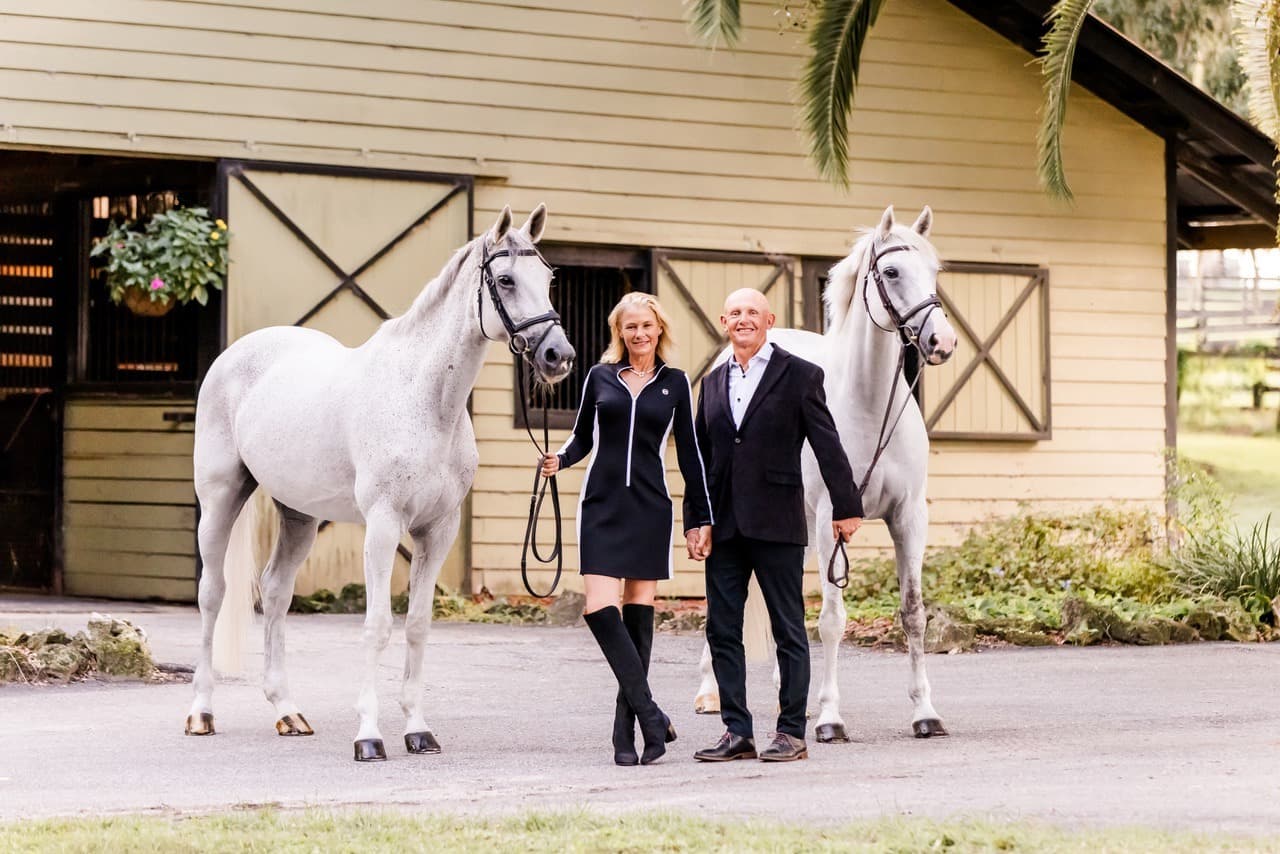Opening Your Sail on Cross-Country on Day 2 of the 2024 ECP Symposium
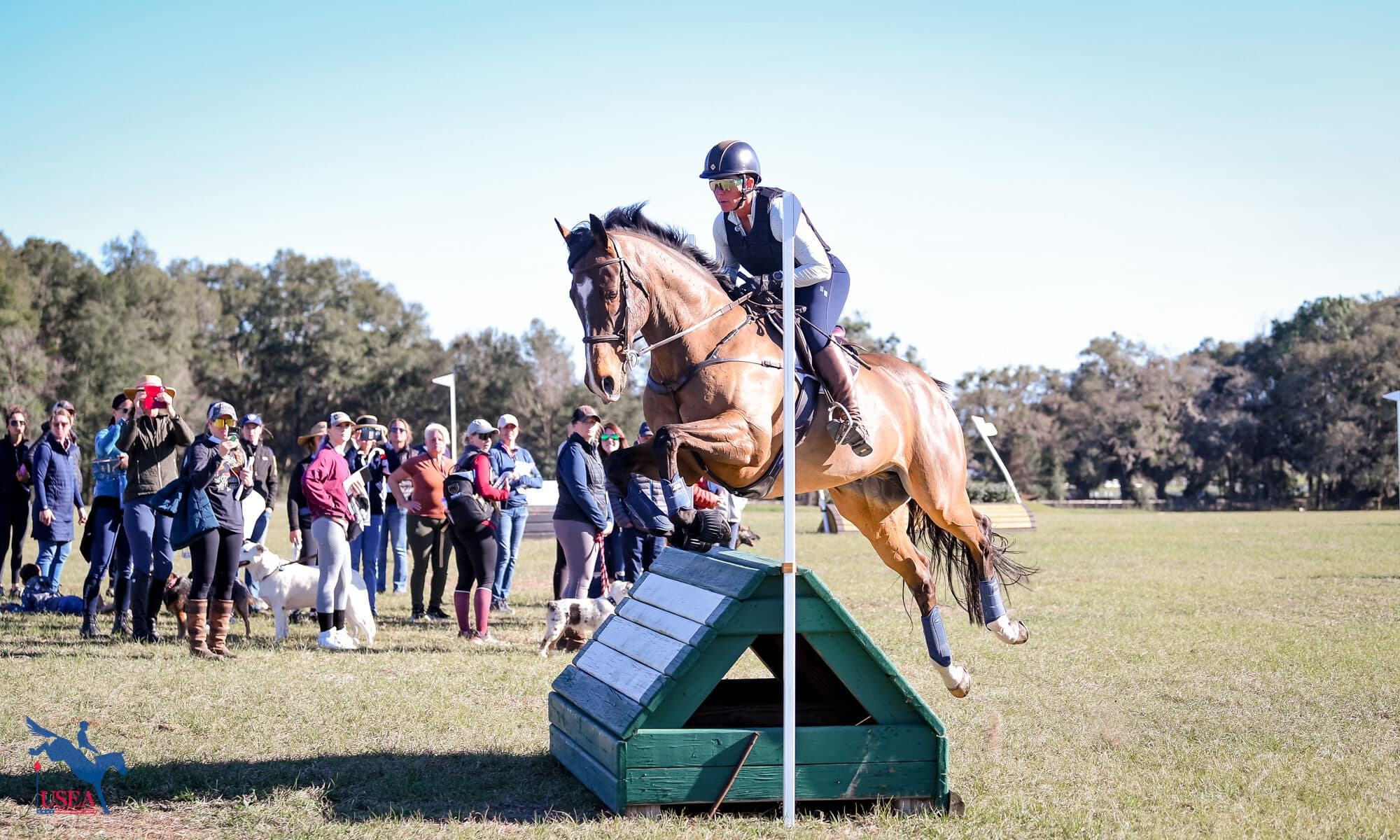
Ocala, Fla.—Jan. 31—Olympian and five-star winner Karen O’Connor took the literal reins at the start of day 2 of the USEA Eventing Coaches Program (ECP) Symposium as she spoke about proper cross-country position in front of a group of enthusiastic riders and coaches at the Florida Horse Park.
The ECP Symposium brings together coaches from around the country for three days of learning and discussion, as well as question-and-answer sessions from top coaches and other industry experts. Yesterday the focus was on dressage, and today participants got a chance to learn about teaching cross-country riding from Intro through Preliminary.
At the start of her lecture, O’Connor admitted that even she struggles to teach cross-country. She usually insists on seeing a rider show jump first so she can get a good idea of their skills over fences.
“It’s a huge responsibility to make sure the outcome is correct,” she said. “I think it’s very easy to get into trouble out there, and there’s a huge progression on the exercises depending on the age of the horse and the experience of the rider, et cetera. I like to keep things as simple as possible so the student and the horse understand. If you think about cross-country riding, there’s only three things that are going on there, and they repeat themselves over and over again—your gallop from fence to fence, you get ready for the jump, and you jump the jump—and it repeats itself. Because that is the situation, there are three very different positions to acquire the correct direction, speed, and balance within the correct rhythm and tempo.”
She then demonstrated a half bridge with a pair of reins that she likes to use for safety and balance.
“I always teach a single bridge,” she said. “That bridge can literally go down into the withers so you can support your position a little bit, and it keeps your horse quieter. The nice thing about the bridge is you can let it go. It’s a good security blanket.”
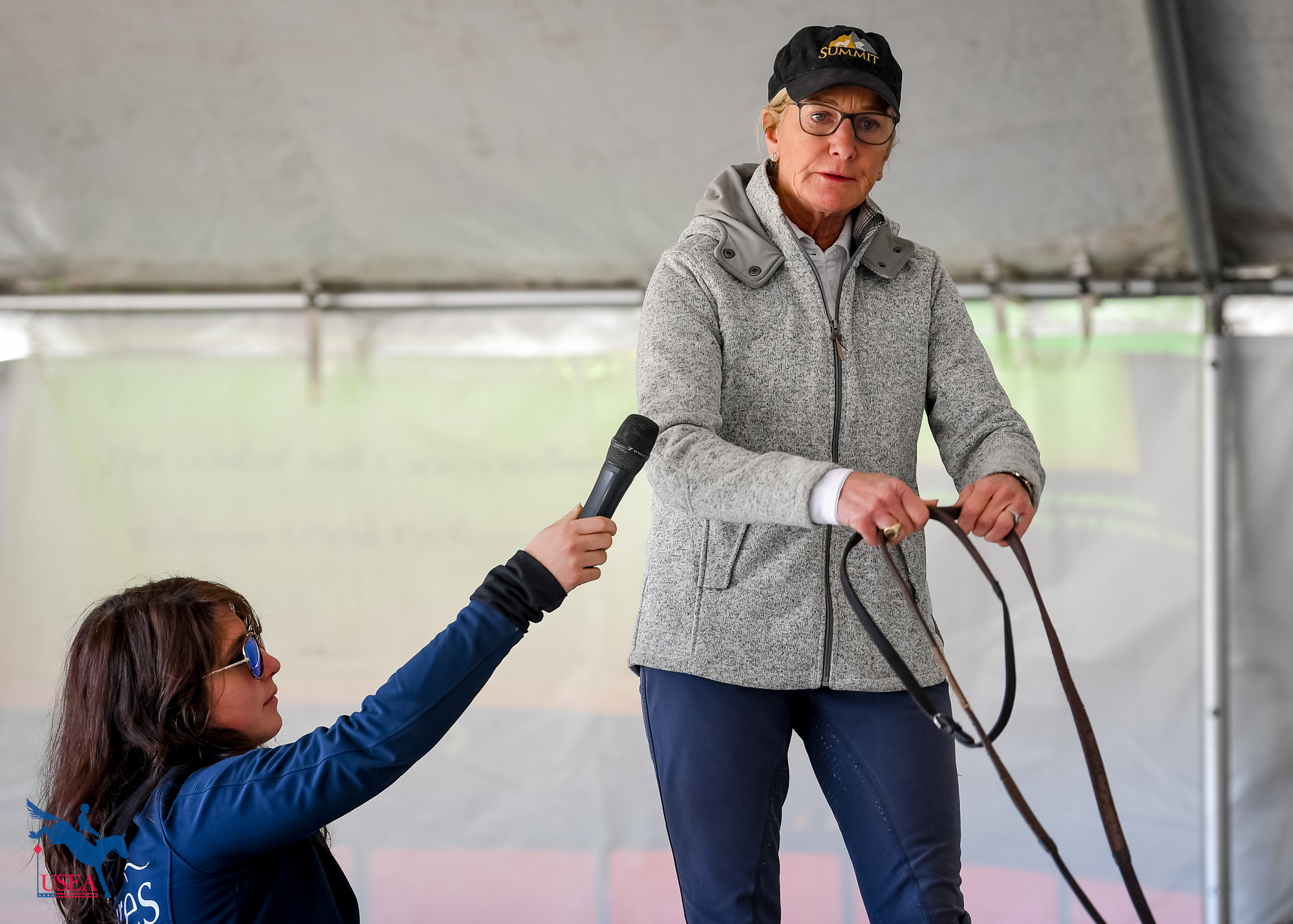
She discussed where to place the foot in the stirrup iron—towards the back of the ball of the foot for cross-country to give a platform for a secure position.
Then she spoke about the three cross-country positions—galloping, balancing, and approaching the jump/jumping.
“The galloping position you want to look a little bit like a race rider with a hip angle that’s closed enough for the terrain and the speed. Then you open going down a hill or to slow down,” she said.
A big part of cross-country is being in the middle of the horse at all times, so proper balance is key. “If I go faster, I’ll slide my hip back. I keep the bridge, keep my hip back, and bend my elbows, and that’s about it,” she said. “How many of you guys have seen people at Novice level, and they’re sitting the entire cross-country? It drives me nuts. There’s no reason for them to not be able to support their body out of the saddle, and it’s critical because once you have to do the other things, like preparing for the jump, the horse is going to go numb and go, ‘Yeah, whatever.’ Keep your riders out of the saddle. When you want them to go slower, get them to straighten their arms without any pulling on the reins.”
O’Connor likened the balancing position to opening a sail. “If you’re teaching correctly, it’s a lightbulb for riders because they go to stand up to slow down without pulling, and the horses feel the wind resistance and slow down,” she said. “Body language is absolutely everything when you ride. If you go up a hill, you’re going to be closed; if you’re going down a hill, you’re going to be open.”
When balancing a horse, O’Connor stressed to never use your bicep, always the tricep. “Leverage has huge influence,” she noted.
She described the position as an exclamation point compared to the final position, jumping, which is more of a C shape.
“I stand up and open my sail,” she said. “Does the horse respond to the jump? The fastest horses will. What if he doesn’t respond? Use leverage to slow him down. Leg a little forward, stand up. Feel the hind leg sink, then go into third position which is jumping position or C position. How much you sit depends on the speed to the jump. The smaller the jump, the slower you have to travel.”
O’Connor stressed to the coaches that if their rider can’t get their horse back in the arena, they’re not ready to go out to a cross-country field—the horse will go running or the rider will say, “‘I can’t do this,’ and get discouraged. Don’t prove to them what they can’t do,” she added.
She also added the less common fourth position—going down a drop. In that instance, a rider would allow the horse to use its head and neck, and the rider’s hip angle would open and close with the movement up or down the drop.
After the lecture, the group headed out to the cross-country course to meet with four riders of varying levels for one-on-one sessions.
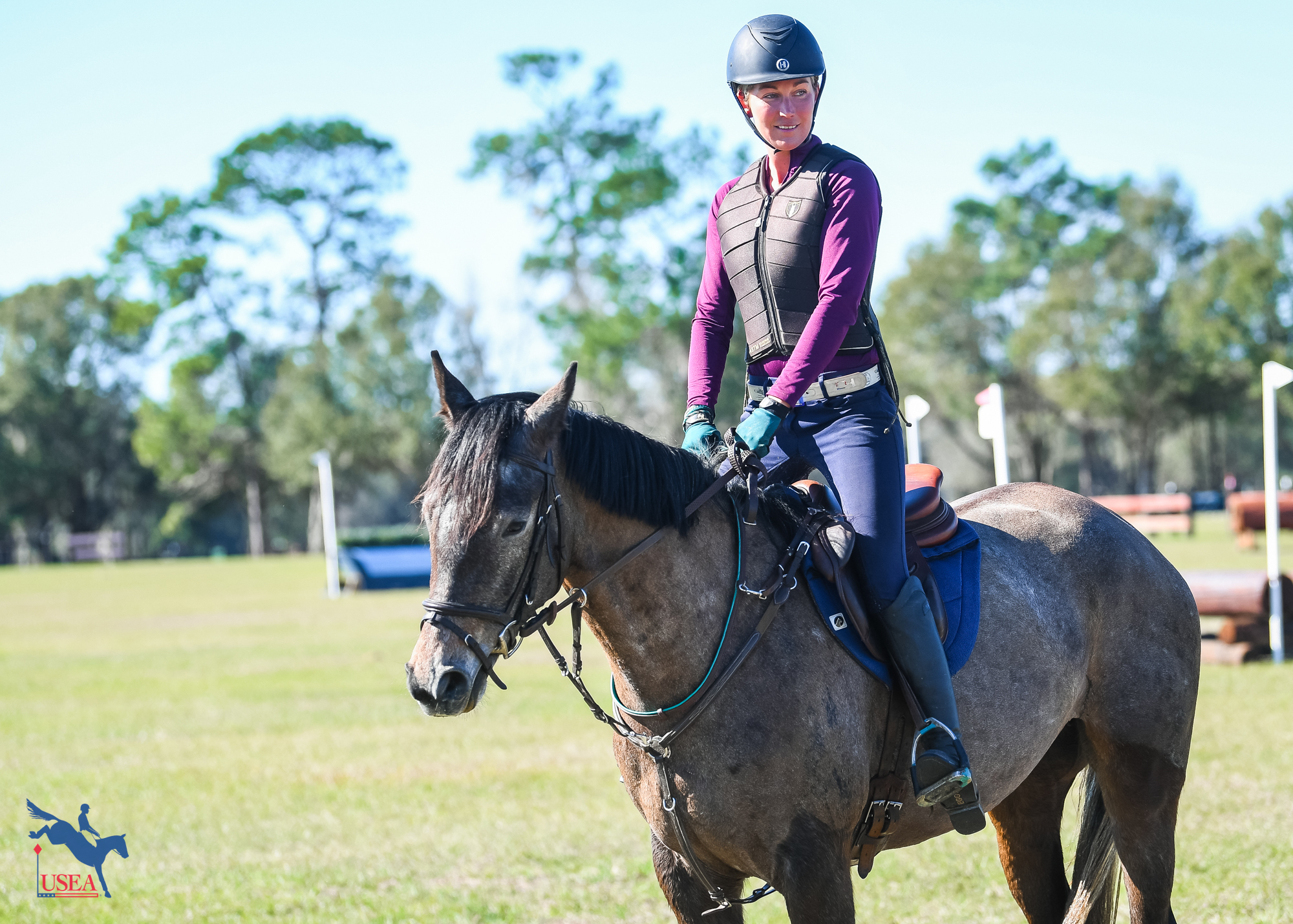
“Why is cross-country schooling so difficult?” O’Connor asked. “On course they have adrenaline. At home they could be anxious. How can you give your students adrenaline? Send the horse forward, bring it back. Nothing crazy, just make sure you have adjustability. Robin [Walker’s] lesson yesterday was, go forward. You don’t have to pull or kick. Only use the reins if they won’t whoa, only use legs if they won’t go. Your hips swing and keep you in the middle.”
The first rider, professional Heather Lawson, rode Helluvayear 20, a coming 4-year-old mare who’d only schooled cross-country three times after being broken in last July.
O’Connor coached her and had her “walk, trot, pop” over a small log. She encouraged her to “row the boat” with her arms when riding any green horse towards a fence they might be unsure about and to give the mare plenty of time in a straight approach to see each jump since green horses think slower.
As they did in yesterday’s dressage sessions, each group of participants had an ECP mentor coach help them come up with ideas for a lesson plan and things they would work on or wanted to improve for each horse and rider.
One group said they’d want the rider’s position to encourage straightness for the horse, which O’Connor said was hugely important for young horses when you just want to get from point A to point B.
With a green horse, she encouraged a little bit of a lower seat for security and said to never be afraid to slip the reins.
By the end of the ride, the mare had jumped a brush fence, which she’d never done before, and confidently trotted through water.
By the time Sarah Alexander and Lambrusco W came out to show off her Novice skills, several truckloads of draft horses had arrived at the park for a weekend horse show, and some were hitched to their carriages and driving around the far portions of the cross-country course.
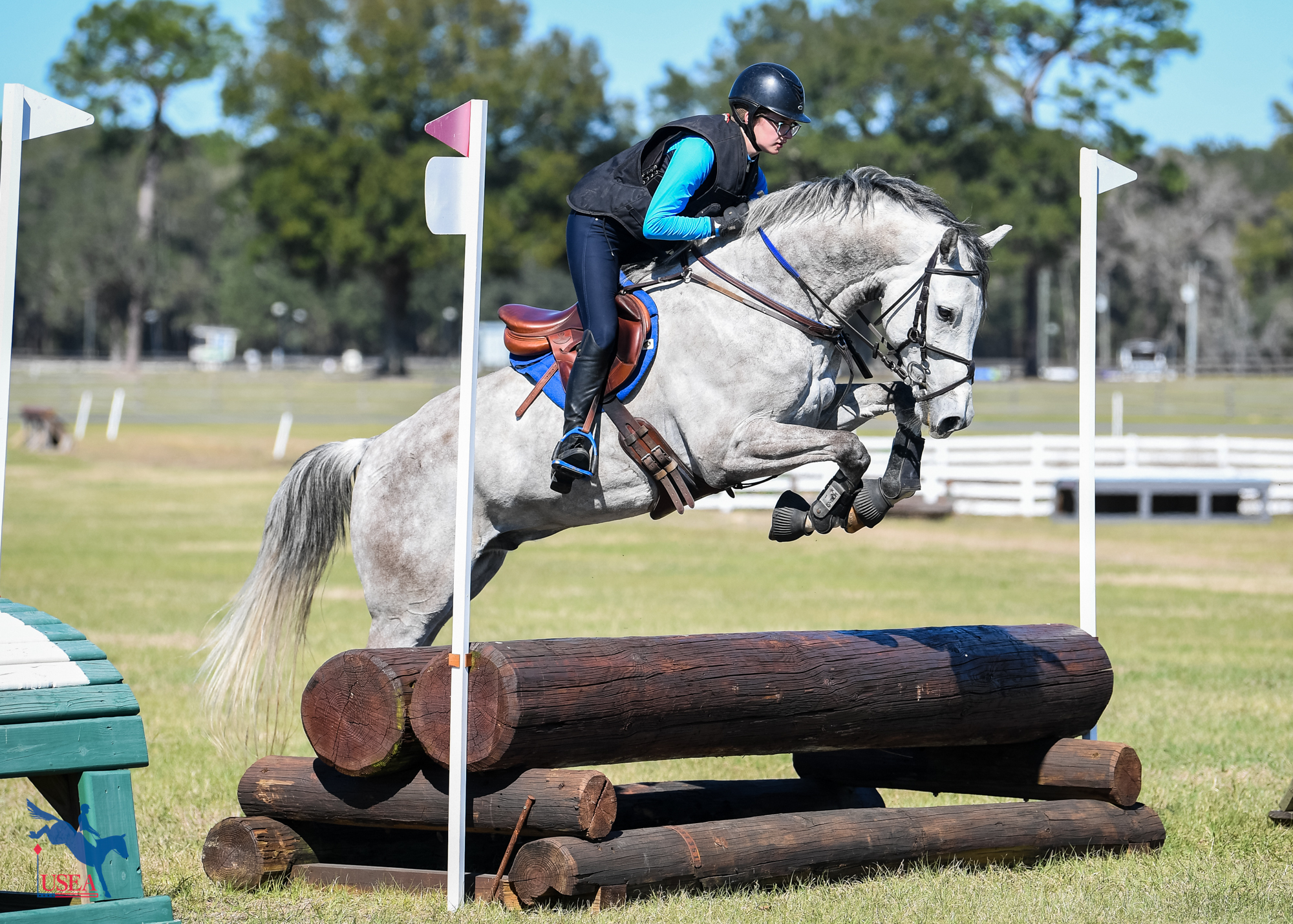
Lambrusco W was quite unnerved by a six-in-hand carriage, so ECP mentor coach Emily Beshear went right to work helping Alexander work him through his nerves.
She had the young rider use a wider contact to keep her elbows moving and directing his attention. Keeping with the theme of rider position, Beshear asked her to think about how she could slow him down with her body and not her hands. She had her stand up out of the saddle in walk and trot to work on her balance. She worked on a figure-8 around some jumps and had Alexander work on keeping an open hand as the gelding wanted to get a bit low and behind the vertical in trot.
As the ride went on, Beshear remarked that the speed was under control, but that Alexander needed to trust to allow the gelding’s nose out so he’d be able to see the fences when they started jumping.
When they started jumping, the gelding stopped at a brush and ran out since he was distracted by a group of horses hacking over the hill. “The horse has to stay connected to you, no matter what it’s doing,” said O’Connor. “The thing you don’t want to allow is for it to swing its quarters like that. It’s got to stay straight. If it was a more experienced rider, they would just get out of the saddle and send it forward, but you couldn’t do that [today.] I think her position has to dramatically change so she can learn that she is strong. She’s riding from her heel to her bicep.”
At the end of the day, the group came together to discuss the cross-country rides they’d seen, and O’Connor echoed the overall theme of the day.
“Cross-country is the most dangerous part of our sport. That’s why it’s a risk sport; because it involves speed and another brain,” she said. “We have to be very careful to teach our students that the balancing of the horse starts wherever you need to and with however much time you have, but it has to be finished just before you’re going to make your decision on the timing of what your spot is. Then you ride forward and build power.
“Keep it systematic. The horses want it simple,” she added. “It takes a very sophisticated coach—intuitive and a little bit academic—to make sure your riders have the information. There’s lots of variables—anything can happen. That’s the art of cross-country—being in the moment.”
Show jumping wraps up the Symposium tomorrow after a lecture from equine law attorney Yvonne Ocrant at 7:30 a.m.
This coverage is brought to you by:

Helpful Links:
- ECP Symposium Fast Facts
- ECP Homepage
- Event Coverage
- Upcoming ECP Workshops and Assessments
- Directory of ECP Certified Coaches
- ECP Certification Information
Don't forget to follow the USEA event coverage on social media!
About the USEA Eventing Coaches Program (ECP)
Coaches are essential to the training of riders and horses for safe and educated participation in the sport of eventing. The USEA Eventing Coaches Program (ECP), formerly known as the Instructors’ Certification Program (ICP), was initiated in 2002 to educate all levels of eventing coaches with crucial training principles upon which they can continue to build throughout their teaching careers. ECP offers educational workshops and assessments by which both regular coaches, Level I through Level V, Young Event Horse (YEH) coaches, and Young Event Horse professional horse trainers can become ECP certified. Additional information about ECP’s goals, benefits, workshops, and assessments as well as names and contact information for current ECP certified coaches, YEH coaches, and YEH professional horse trainers are available on the USEA website. Click here to learn more about the USEA Eventing Coaches Program.
The USEA would like to thank Parker Equine Insurance, the United States Pony Clubs, and Strider for their support of the Eventing Coaches Program.




















